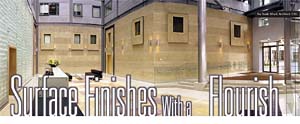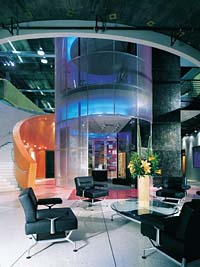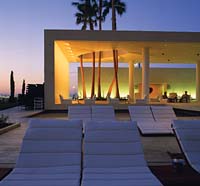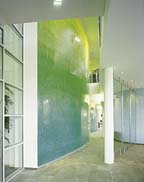
Although a stylish, modern surface finish in appearance, polished plaster dates back to classical times with its origins in Ancient Egypt, Greece and Rome. The composition and application of today's finishes are very similar to ancient stuccos but it is the Venetian plasterers who can be credited with the development of the Marmorino finish to emulate marble. Quick to appreciate the aesthetic and economic benefits of the material, they were able to produce attractive, hardwearing, luxury finishes at a fraction of the weight and cost. In recent years, polished plaster and decorative finishes have seen a renewed interest and have been used extensively in many projects in the United States and worldwide.


All natural products
Through extensive investment, research and development, today's range of product finishes has never been greater. It is the designer's first choice and can create highly individual or abstract effects to complement the most modern interiors. Alongside this, emulating quarried stone, such as marble and limestone, is achieved cost-effectively-particularly for columns and curves-and with significantly less weight.Although in America the term "Venetian plaster" is often now applied to almost any colored and polished plaster surface, the quality and consistency of product formulations can vary greatly.
Well-formulated natural products are not only the most stone like in look and feel but are generally the easiest to apply. The synthetic based products are usually a little more flexible, but are generally softer, contain higher levels of volatile organic compounds and have a more "plastic" feel.
Decorative finish can be supported on a variety of substrates. These include concrete, brick and blockwork, drywall and existing plaster surfaces, which can be irregularly shaped, whether flat, angular or curved. The substrate is prepared with undercoat plasters to provide a perfectly flat surface background for the bond coat and subsequent layers.
All decorative plasters should be applied by trained plasterers so the quality of workmanship is consistent and work can be guaranteed for several years. Plasterers apply a bond coat to the prepared wall surfaces after which a number of progressively thinner layers are applied by trowel to thicknesses ranging from 3 millimeters. to as little as 0.5 millimeters. The plaster is allowed to dry overnight and is then treated with wax to preserve the range of tones and luster, and protect from dust. In order to achieve a completely seamless, continuous finish, most companies do not permit the use of day-joints and each section of wall is finished in a single, uninterrupted process to give a natural looking, monolithic appearance that exudes toughness, permanence and luxury.

Polish and shine
RTKL is a multi-sector, multi-disciplinary planning, architectural and creative agency employing 900 professionals worldwide, including eight United States offices and locations in London, Madrid, Tokyo and Shanghai.For its new Dallas office, the firm recently refurbished a notable 1950s modernist designed bank that featured opulent use of materials, such as maple-paneled walls, terrazzo floors, white marble columns and gold leaf. Many of these materials have been retained and juxtaposed with newer design elements.
The original banking hall comprised a 60,000 square foot, column-free, two-story space that RTKL reconfigured to express its core design philosophies, one of which involves a radical reinterpretation of the traditional office landscape. Stripping the original space down to its "bare soul," RTKL used the prevailing architectural language to create rich textures, bold color and crisp, angular shapes, all illuminated by industrial lighting for a spatial experience. Around 10,760 square feet of a polished plaster, manufactured by Armourcoat, was used by the architects on feature walls to add a new sense of depth and layering to spaces, as well as to define circulation and boundaries.
For example, a red spatulata finish incorporating the RTKL logo was used in an abstract, cubist-style panel behind the reception desk. A grey spatulata finish adds to the monolithic effect of a massive free-standing feature wall. The product's ability to be applied to curved substrates is demonstrated in its use on the curved staircase walls.
RTKL Architect Mark Lauterbach says, "We used this method because it offered us unlimited color choices, depth of material and texture, and also helped bridge together the existing gold leaf, marble, terrazzo and exposed concrete finishes. It also has a very tactile quality and reflectivity that adds to the richness and layering of our offices."
These polished plasters are suited to both traditional and modern interiors and have more often been used for corporate, commercial, retail and domestic applications.
The RTKL Dallas office-ranked by World Architecture as the world's seventh largest design firm-signifies that the esteem among European architects and designers for prestigious retail, commercial, office and high-end residential applications has now spread to the United States.
